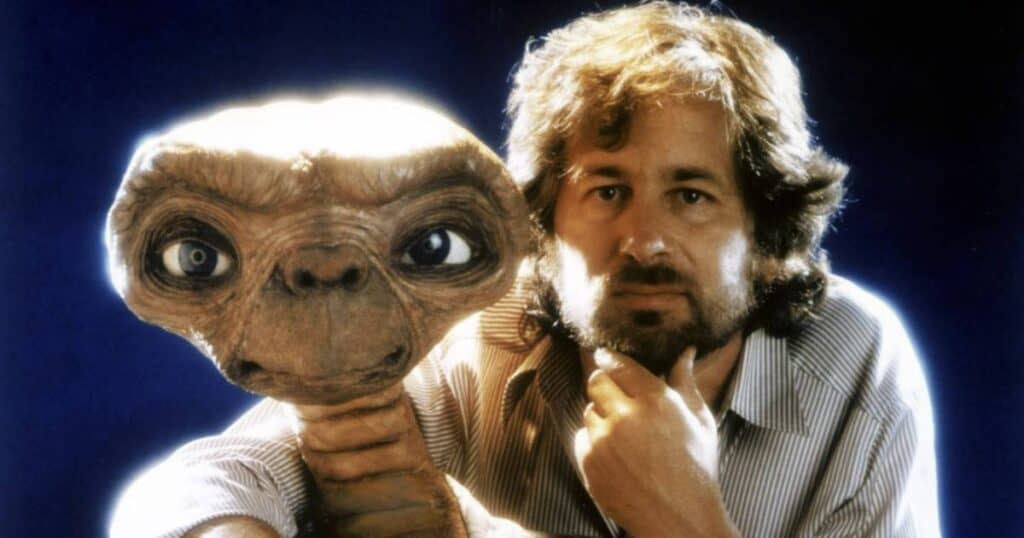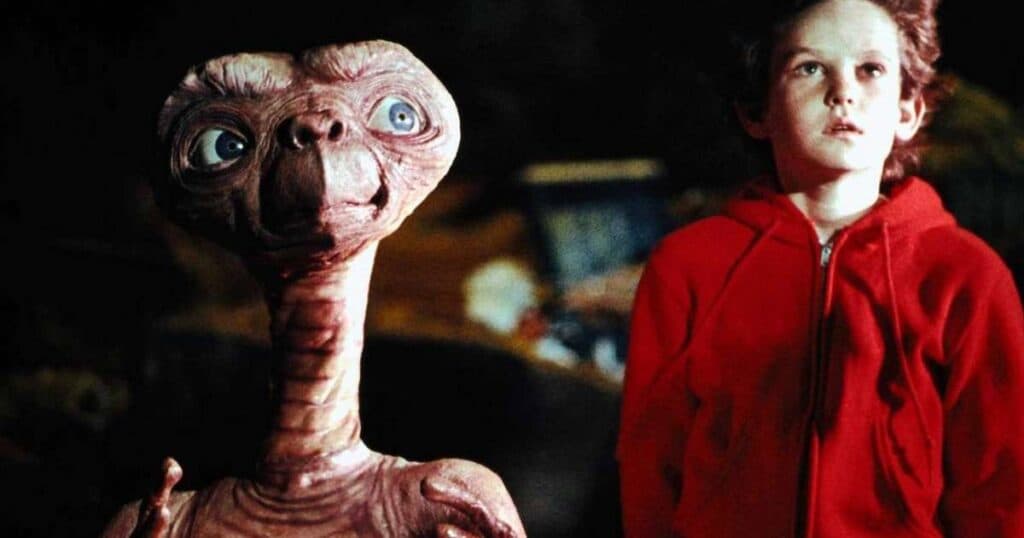
In hindsight, it’s a story so simple a child could’ve come up with it. A story about a boy feeling lost and alone in the world. He befriends a small alien, similarly lost and alone in the world. Their bond is almost immediate, and in a few short days, they become the best of friends. But the alien doesn’t belong here, and the boy knows it. One day soon, that loveable creature will have to return home, and when he does, he won’t be coming back… The end.
It might not sound spectacular on paper, but with the right storyteller in charge, the result broke millions of hearts and earned hundreds of millions of dollars. When Steven Spielberg’s E.T. the Extra-Terrestrial came out in June of 1982, the world was not quite prepared for just how much of a phenomenon the movie – and its title character – would become. Before long, it would be the biggest movie ever released. It wasn’t cynical or violent, it made no excuses for how sentimental it was, and it did not play fair when it came to toying masterfully with the audience’s emotions. And the people loved it almost as much as the boy loved his extraterrestrial pal.
Sit back and be good as we find out WTF Happened to this movie!
For as gentle and universally beloved as E.T. the Extra-Terrestrial is, it might be difficult to believe that it began life as a horror project, inspired by one of the most infamous alleged alien encounters in American history. It all started with another hit movie: Spielberg had made Columbia Pictures a lot of money with his sci-fi epic Close Encounters of the Third Kind. Naturally, the studio wanted Spielberg to make a sequel, but the director was not interested. Since he owed Columbia another contractually obligated movie, Spielberg thought he could fulfill said contract with a different movie revolving around aliens. During his research for Close Encounters, Spielberg had learned of an incident known as the “Kelly-Hopkinsville Encounter,” in which a small group of farmers claimed they’d been terrorized all night by a collection of “little green men.” Spielberg thought there were possibilities in this farfetched tale for an effective horror film which would be about a family under siege by a handful of gremlin-like monsters from outer space.
To craft the script, Spielberg hired a young up-and-coming writer named John Sayles, who had penned the screenplays for Piranha and The Howling and was also gaining traction in the industry thanks to his independent directorial debut The Return of the Secaucus Seven, which had impressed Spielberg’s colleague Kathleen Kennedy. Spielberg had no interest in directing the film, instead planning to give it to Tobe Hooper, who had shocked everyone to pieces with The Texas Chainsaw Massacre a few years earlier.
While Spielberg was off making Raiders of the Lost Ark, Sayles wrote his first draft of “Night Skies”, which was a lean and mean horror movie heavily influenced by the John Ford western Drums Along the Mohawk. And although Sayles accomplished his assignment, Spielberg found himself turned off by the intensity of the script, and started to have second thoughts about the project. Shooting “Raiders” was a trying time for the director, and he found himself yearning to make another movie like “Close Encounters,” something that would be more tranquil and spiritual in nature. Still, one element that stood out in the “Night Skies” script was the ending, in which the villainous creatures leave behind one of their more gentle brethren, nicknamed “Buddy,” who had befriended the family’s young autistic boy. Spielberg had long wanted to make a film about a child dealing with the divorce of his parents – something he would more directly confront with 2022’s The Fabelmans -, and he then saw the possibilities of telling that story through the eyes of a boy from a broken home who strikes up a friendship that changes his life.
Spielberg found a new screenwriter in the form of Melissa Mathison, who at the time was dating Indy himself, Harrison Ford, and regularly visited the Raiders production. Mathison was also a screenwriter and was moved by the idea of the alien being left behind by his tribe, but she was reluctant to write the screenplay because she’d just had some unpleasant experiences working on The Escape Artist and The Black Stallion for producer Francis Ford Coppola. But as we know, Spielberg often gets his way, and with the help of Harrison Ford, he convinced Mathison to take the job.
When he was done with Raiders, Spielberg had to break the news to Columbia that he’d soured on the Close Encounters pseudo-sequel “Night Skies,” instead wanting to prep this coming-of-age family film about a boy and his lost alien friend. It would be heavily inspired by the occasionally grim Disney movies of his youth, like Bambi, but believe it or not, Disney films were not box office gold in the early 1980s, and Columbia made it clear they had no interest in making this family film. To appease the studio, Spielberg offered to create a “special edition” of Close Encounters, which would be cheaper to produce than a whole new movie, and it would include brand new footage, most importantly a look inside the alien space ship. Spielberg then brought his new alien project to his old bosses at Universal, where he’d made Jaws and, less successfully, 1941. To round everything out, the “Night Skies” script was then radically altered, with Spielberg retaining some of the broad strokes but changing the menace from aliens to ghosts. That new project would be called Poltergeist, and Tobe Hooper would direct it.
After an original title of “A Boy’s Life,” Spielberg and Mathison were now referring to their alien project as “E.T. and Me,” which would later get trimmed to simply E.T., though of course, the full title is E.T. the Extra-Terrestrial. Mathison would tape-record the long story conferences at Spielberg’s home, where he was editing Raiders, and then she would go off and write pages, which he’d then give notes on. Their intense prep on cracking the story was so involved and detailed that by the time Mathison completed the first draft, Spielberg found it was ready to go, calling it the best first draft he’d ever read. The budget for the film was set at $10 million, a relatively safe number compared to the much larger budgets carried by 1941 and Raiders. Production ramped up almost immediately following the completion of Poltergeist, in which Spielberg was heavily involved.
In terms of casting, Spielberg met with dozens of young actors to play the primary three leads: Elliot, his young sister Gertie, and older brother Michael, who was partially based on Spielberg when he was a teenager. Henry Thomas was recommended to Spielberg by production designer Jack Fisk, who’d just directed Thomas in a film called Raggedy Man. Thomas got the part after a now-famous audition in which he convincingly cried over losing his best friend.
Drew Barrymore had auditioned for Poltergeist but wasn’t quite the right fit, but her spunky attitude – coupled with a farfetched story she fabricated about being in a punk band – ensured she was just right for the precocious Gertie. Theater actor Robert MacNaughton made his feature film debut as Michael after auditioning a reported eight times. To play the matriarch of the family, Spielberg allegedly wanted Shelley Long, who was still a year away from hitting it big on Cheers. Long, however, turned down the role to be in the notoriously terrible Ringo Starr movie Caveman, which presumably was one of the bigger mistakes in her career. Spielberg instead hired The Howling actress Dee Wallace after seeing her in Robert Zemeckis’ Used Cars, which he produced. Peter Coyote, who had auditioned for Indiana Jones – poorly, he later admitted – would play the mysterious scientist Keys. A young C. Thomas Howell would land a smaller part just a year before breaking out in Coppola’s The Outsiders.

With the primary humans cast, the attention turned to “E.T.” himself. Spielberg hired Carlo Rambaldi, who’d worked on Close Encounters, to design his lead creature, although legendary make-up wiz Rick Baker would later hint that some of his design work on the abandoned “Night Skies” had been used.
Spielberg thought E.T. should be scary-looking when the characters first meet him, and it’s only after you get to know him that you fall in love with the odd little space botanist. Spielberg wanted him to have “wizened eyes” and gave Rambaldi pictures of Ernest Hemingway, Albert Einstein, and poet Carl Sandburg for inspiration. Rambaldi supposedly asked for nine months to work on the E.T. design, but Spielberg would only give him six. Obviously, the Italian artist delivered.
When E.T. is on the move, the filmmakers had to figure out just how to make the alien convincingly walk, and they used a combination of little people and a small boy who had no legs, depending on the shot. When E.T. was in a sitting or standing position, a crew of puppeteers would operate him from a different room to further establish him as just another member of the cast. It got to the point that people would treat E.T. with as much respect as they would the human cast-members.
Spielberg did his best to hide E.T. from his actors until their characters met him for the first time. In the scene where Elliot introduces his wrinkly new buddy to his siblings, MacNaughton and Barrymore’s shocked reactions were quite real. When E.T. is talking to Elliot or one of the other kids, Spielberg would be just off-camera reading his lines.
The film was mostly shot in chronological order; Spielberg wanted his young actors to bond with the alien throughout, so that when E.T. goes through some major struggles in the second half of the film, their heartbroken reactions would be genuine. Drew Barrymore was truly affected during the scene where Gertie sees E.T. on his death bed. The young actress was quite attached to E.T., so much so that she would bring him lunch and sometimes put a scarf around him to keep him warm, and years later Barrymore admitted that she thought the creature on set was real. At the end when the kids say goodbye to their friend, Spielberg wanted them to really feel like it was the last time they’d ever see him. Is the guy an evil genius or what?
Spielberg did not have children at the time, but making E.T. and the bond he formed with the young cast made him realize that he was actually ready to be a father. He ended up seeing the kids more often than their own parents did during those several weeks of production. However, it wasn’t just all play and no work. They had to do schoolwork on set throughout filming; sometimes they’d wrap a scene, go do homework, then come back to set when the next shot was ready. Because of labor laws, the shooting schedules generally revolved around the kids’ availability. Drew and Henry could only shoot around 4-6 hours a day, Robert just an hour or two more.
Perhaps this schedule juggle created an atmosphere of tension on the set because many years later, Spielberg would admit to being impatient and rude with his crew until Kathleen Kennedy – E.T. being her first official credit as producer – pulled him aside and gave him a serious talking-to. Spielberg said Kennedy’s stern words about his unacceptable behavior prompted him to change the way he worked from that day forward.
E.T. took about two months to shoot, coming in on time and on budget, a lesson Spielberg finally learned after Jaws, Close Encounters, and 1941. It was scheduled to be released on June 11th, 1982, ironically, just one week after “Poltergeist” would begin terrifying moviegoers. The film tested in a nearly-finished form, complete with music and sound effects, which is a fairly unusual practice in Hollywood. Once audiences got a taste of it, there was reason to be optimistic, even though initially Spielberg was convinced he had not made a film that was going to be a commercial hit. When he first showed it to studio executives, he made sure they saw it with a preview audience, so the suits would see the excited reactions from the people who would end up buying tickets all summer long. Its very first screening was in Texas, and it went off like gangbusters.
The film had its official world premiere out of competition in May at the Cannes Film Festival. Much to Spielberg’s delight, the famously judgmental crowd ate the movie up, lavishing it with a huge standing ovation that lasted minutes. That’s when the director sensed he had an international hit on his hands, one that British TV personality Marshall Lee astutely said was designed to “pluck your heartstrings and pick your wallet at the same time.”
Indeed, the picture landed on Earth with a considerable impact. It opened with a very respectable $11 million, its approximate production cost, and it became clear that E.T. would not go away, holding the number one spot for six weeks. Incredibly, its fourth-weekend box office take of $16 million was, at the time, the highest-grossing weekend for any movie ever. It would stay in the number one or two spot for every weekend until mid-October, something that’s simply unthinkable nowadays. Ultimately, E.T. would surpass Star Wars as the highest-grossing film of all time, a title it held until it was dethroned by yet another Spielberg movie, 1993’s Jurassic Park.
Critics showered the movie with praise, and it was acknowledged with nine Academy Award nominations, including Best Picture and Best Director. Surprisingly, it only won four, losing the major awards to Spielberg’s future Jurassic Park star Richard Attenborough and his biopic Gandhi. Attenborough would later say he thought “E.T.” would win, and that it should have won, calling it inventive, powerful, and wonderful.
E.T. was re-released in 1985 and again in 2002, with the latter featuring some digital enhancements and scenes that were cut from the original. Most notably, it replaced the government agents’ guns with walkie-talkies, which led to plenty of scorn from the fan community. Years later, Spielberg would admit he regretted these so-called upgrades, and said that he’s no longer interested in making digital changes to any of his old films. Furthermore, he now hopes people ignore the re-release and stick with the original version. Either way, between its original box office run and the various theatrical re-releases, E.T. has gathered up almost $800 million worldwide.
Naturally, there was talk of making a sequel to the massive hit, and Spielberg and Mathison even wrote a treatment. It would have been a much darker film, closer in tone to Sayles’ “Night Skies” script than E.T., but ultimately it was decided to leave well enough alone. Good thing too, because if you read the treatment for “E.T. 2: Nocturnal Fears,” you’ll wonder just what in the hell Spielberg was thinking. That’s a WTF story for another day.
But we’ll always have E.T., and for that, we should be grateful. Yes, it’s emotionally manipulative, sappy and frequently cloying, but it also simply works. There is no doubt about that. At the end, like Elliot, we’re sad to see our little friend go. Unfortunately for Elliot, his goodbye is final, but lucky for us we can always revisit E.T. over and over again…
Originally published at https://www.joblo.com/wtf-happened-to-e-t-the-extra-terrestrial/

